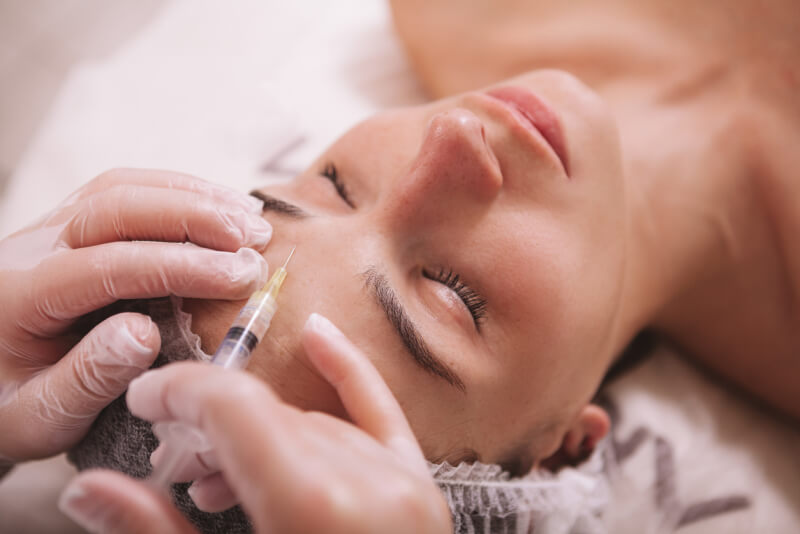Botox complications are rare, but the injectables, also known as botulinum toxin, can cause adverse effects for some people. When Botox is injected into first-time patients, some complications, including bumps on the forehead, occur, causing significant distress. But the fact is, these are natural reactions that are usually short-lived.
What are the causes of bumps after Botox forehead? There are several factors to consider on why this reaction occurs. If you’ve set your sights on getting Botox to remove unwanted facial wrinkles, particularly forehead lines, this guide will help you stay informed about Botox cosmetics on the forehead.
Is It Normal to Have Bumps on the Forehead After Botox?
It’s only common to experience swelling at the injection site following a Botox treatment. This typically resolves after a few days. The large, hard bumps visible at the injection site are usually caused by some trauma to a local small blood vessel. As long as you don’t feel any pain and the bump isn’t developing in any way, then you need not fear. However, if you think that your symptoms are more serious and require a thorough check-up, inform your Botox treatment provider as soon as possible.
Are There Dangers of Treating the Forehead With Botox?
Botox is considered a relatively safe cosmetic treatment, no matter which part of the face it’s administered. It’s well known to treat fine lines and wrinkles in the forehead area, also known as frown lines, around the eyes, and along the neck.
Aside from bumps or swelling, other potential side effects of a Botox treatment include:
- Localized redness
- Localized bruising and bleeding
- A headache and flu-like symptoms
- Temporary or brief weakness and drooping at the treated area (e.g., drooping eyelids)
It’s essential to select your treatment provider carefully, as having your Botox administered by a highly qualified and experienced doctor can reduce your risk of side effects. On the other hand, an unskilled practitioner may inject too much Botox into your face, which will make your face seem too frozen.
How Long Does Forehead Botox Last?
After Botox injection, you’ll notice that your muscles will slowly freeze in two days, with the full results appearing after a week. The wrinkle-free results of Botox usually last three to four months before gradually wearing off. If you love the outcome of your Botox, the only way to extend its effect is by getting injections repeatedly. Unfortunately, there aren’t any proven procedures that can extend the appearance of Botox, but there are things one can do to improve the benefits of the treatment. These include consistent self-care, regularly wearing sunscreen, taking antioxidants, and managing your overall wellness.
Remember that due to the muscle paralysis caused by the Botox injections, there aren’t many ways to make it wear off faster. Also, unlike hyaluronic acid filler, there’s no enzyme to dissolve the filler right away. As the results of Botox cosmetic procedures are only temporary, you’ll have to wait and give it time.
How Much Botox Is Permissible on the Forehead?
The horizontal lines in the forehead and the glabellar lines among the eyes are the two areas of concern with wrinkles for the forehead:
Women are allowed to be injected with up to 20 units of Botox for their forehead lines. And up to 30 in the glabellar area, allowing up to 50 units into the forehead in a single treatment. Meanwhile, 30 units in the forehead and 40 units in the glabellar area are approved for men.
To make sure your body will react to Botox, most practitioners start with a low-unit dosage and examine the results over two to four weeks. The dosage of 20 units is subdivided into four units of 5 forehead injection sites. If you want to have any other surrounding area of the forehead treated with Botox, the only next FDA-approved area for Botox treatment is the crow’s feet or wrinkles near the eyes (up to 16 units per side for men and women).
Is Botox on the Forehead Safe?

Just like any other drug or injectable treatment, Botox treatment has its threats. The FDA reminds patients with a precaution: “Botox may possibly spread from the injection area to produce botulism symptoms, including muscle weakness and breathing difficulty, which can occur hours or weeks after being injected.”
Most of the side effects are connected with the injection process itself: Bleeding, bruising, pain, swelling, and temporary headaches can occur if improperly injected at unintended muscles. There’s also a likelihood of brow ptosis (droopy eyelid or eyebrow). The needle will leave tiny red marks that look like bug bites. This usually vanishes in the hours after your appointment.
To minimize these risks, as well as your chances of having a bad botox and allergic reaction, seek a board-certified dermatologist or plastic surgeon who specializes in cosmetic injectables. It’s essential for patients or those interested in receiving a treatment that they trust only a board-certified practitioner with experience.
Moreover, you’ll also want to avoid some habits and activities 1 to 2 days after treatment. This will lower the risks associated with Botox treatment. Below are Botox aftercare instructions to follow:
1. Refrain from sun exposure
It would help if you reduced sun exposure for at least 4 hours. The heat can increase flushing and raise your blood pressure, which may result in bruising. Thus, avoid the sun for 24 to 48 hours. It’s also most helpful to prevent other forms of heat exposure, such as tanning beds, hot tubs, hot showers or baths, and saunas.
2. Refrain from drinking alcohol
Before undergoing Botox surgery, the Botox injector will encourage the patient to avoid alcohol for 24 hours. Alcohol raises the risk of bruising. This holds after the procedure too.
3. Refrain from touching your face
To stop spreading the toxin, don’t touch your face for at least a day. Some doctors recommend waiting three days. If you got Botox in a different part of your body, avoid touching those areas too.
4. Avoid other skin treatments
Botox needs some time to enter into the muscle. Therefore, for the first 24 hours after your surgical procedure, don’t book other skin treatments like facials, facial massages, exfoliating scrubs, and dermal filler, be it a non surgical procedure or surgical filler treatment. Getting these too soon may diminish the effectiveness of your injections.
5. Refrain from sleeping on the treated areas
Don’t sleep within 4 hours after the procedure and try your best to avoid sleeping in the injected areas. This will lessen the physical pressure and let the Botox settle well into your facial muscles.
6. Wait 24 hours to exercise
If you exercise regularly, it’s best to wait at least a day to work out. Some doctors even recommend waiting for a number of days. Physical activity raises blood flow. This could possibly spread the toxin to unintended areas and reduce its effectiveness at the injection site. It also increases the risk of bruising. After the said period, you can return to your regular exercise routine.
Botox Forehead Cost
The cost of a Botox cosmetic procedure varies depending on your location, the Botox injector, and the number of Botox units used in the treatment. Each unit of Botox averagely costs $10 to $15. So it means treatment of 20 can cost up to $200 or $300 for the cost of units alone. If glabellar lines are included (adding another 20 units of Botox), the total price of units alone could rise to $400 to $600 per treatment.
How to Find the Right Botox Provider
When it comes to the right practitioner to administer your botulinum toxin injections, you’ll want to make sure you choose a board-certified physician, dermatologist, plastic surgeon, or otolaryngologist. Physician’s assistants, registered nurses, and other professionals may be trained and certified to administer the treatment as well. Thoroughly research each person’s credentials before you finalize your decision. If your practitioner isn’t a physician, it’s best to choose someone who operates out of a doctor’s office.
Stay Young and Healthy With the Help of Ethos Aesthetics + Wellness
The well-trained physicians at Ethos Aesthetics + Wellness are very experienced at administering Botox. So whether you’re interested in its anti-aging benefits — no more forehead wrinkle, crows feet, dynamic wrinkles, and acne, or you want its therapeutic wonders to cure muscle spasms, overactive bladder, and excessive sweating — we’re excited to help you achieve your goal in a safe, effective, and guaranteed satisfactory manner. Book your consultation now.







